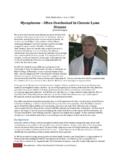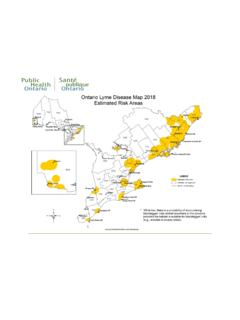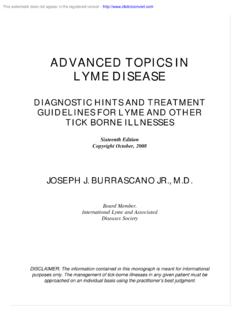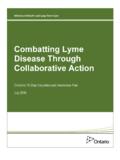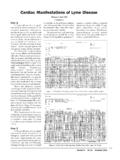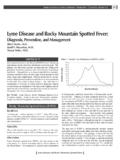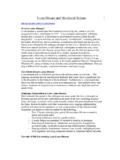Transcription of Laboratory Diagnostic Testing for Borrelia burgdorferi ...
1 4 Laboratory Diagnostic Testing for Borrelia burgdorferi Infection1 Barbara Johnson Introduction Serology is the only standardized type of Laboratory Testing available to support the clinical diagnosis of lyme borreliosis ( lyme disease ) in the USA. It is also the only type of Diagnostic Testing approved by the US Food and Drug Administration (FDA). Of the 77 devices cleared by the FDA for in vitro Diagnostic use for lyme disease , all are designed to detect immune responses to antigens of Borrelia burgdorferi sensu stricto, particularly IgM and IgG (FDA, 2010). Serological tests do not become positive until an infected individual has had time to develop antibodies. In lyme disease , this means that early acute disease characterized by an expanding rash (erythema migrans or EM) at the site of a tick bite cannot be reliably diagnosed by serology.
2 After a few weeks of infection, however, immunocompetent people will have made enough antibodies that serology is useful for confirming exposure to B. burgdorferi in all subsequent stages of lyme disease . Antibody levels remain elevated for months to years aft er the in fection is cured. A variety of direct tests for the agent of lyme borreliosis have been developed. Direct tests include culture of Borrelia from skin or blood and occasionally cerebrospinal fluid (CSF), and detection of genetic material by PCR in skin, blood, synovial fluid and CSF. These tests have specialized roles in research and in academic and reference laboratories but are not available for routine use. Culture and PCR each have distinct limitations that will be noted in this chapter. Diagnostic tests are of clinical value only if they are used appropriately. This has become particularly important in the fi eld of Diagnostic Testing for lyme disease , as both patients and doctors hear conflicting information about the risk of lyme disease in various environments.
3 Furthermore, patients are sometimes given Laboratory Diagnostic tests when they lack objective signs of lyme disease and a history of potential exposure to infected vector ticks. A healthcare provider must estimate the pre-test likelihood that a patient has lyme disease in order to under stand the positive and negative predictive values of tests for lyme disease . Fortunately, there are resources available to assist providers in making this judgement. It is important to know that laboratories may offer in-house Testing for lyme disease 1 The findings and conclusions in this article are those of the author and do not necessarily represent the views of the Centers for disease Control and Prevention. CAB International 2011. lyme disease : An Evidence-based Approach (ed. Halperin) 73 74 Johnsonthat does not require review and approval by the FDA.
4 Because some in-house tests have not been rigorously developed and validated, the Centers for disease Control and Prevention (CDC) and FDA recommend that these tests only be used when their accuracy and clinical usefulness have been documented in peer-reviewed scientifi c literature (CDC, 2005). Unvalidated tests as of 2010 include capture assays for antigens in urine, immunofl uorescence staining or cell sorting of cell wall-defi cient or cystic forms of B. burgdorferi , lymphocyte transformation tests, quantitative CD57 lymphocyte assays, reverse Western blots (Feder et al., 2007), in-house criteria for interpretation of im-muno blots and measurements of anti bodies in synovial fl chapter considers the Diagnostic Testing for B. burgdorferi sensu stricto infection, the only organism established to cause lyme disease in North America.
5 lyme disease also results from infection by Borrelia garinii or Borrelia afzelii in Europe and Asia, as well as by the recently described Borrelia spielmanii in Europe (Wang et al., 1999; Richter et al., 2006; Fingerle et al., 2008). Borrelia valaisiana and Borrelia lusitaniae have been associated anecdotally with lyme disease in some parts of Europe (Crowder et al., 2010), particularly B. lusitaniae in Portugal (Collares-Pereira et al., 2004). Borrelia bisett ii has been cultured from a few patients in Europe (Strle et al., 1997), but has not been shown to cause human disease in North America. Diagnostic tests for B. burgdorferi sensu stricto will not necessarily perform well for infections by other genospecies of lyme disease bacteria, although some do ( assays based on the C6 peptide of the variable surface antigen (VlsE) or the whole VlsE protein). Guidelines for Laboratory diagnosis of European lyme borreliosis are available online in English (Health Protection Agency of the UK, 2010; German Society for Hygiene and Micro-biology, 2000).
6 Two-tiered Serology: the Current Standard for Serodiagnosis in North AmericaThe public health agencies of the USA and Canada advocate a two-step process for measuring antibodies in blood when lyme disease is suspected. The CDC recommends two-tiered Testing both for the evaluation of individual patients (CDC, 1995) and for epidemiological surveillance for lyme disease (CDC, 1997). This recommendation was developed with the participation of the relevant major agencies of the USA, including the FDA, the National Institutes of Health, the Council of State and Territorial Epidemiologists, the Association of Public Health Laboratories and the Clinical Laboratory Standards Institute2 (ASTPHLD and CDC, 1995). The Canadian Public Health Laboratory Network (2007) guidelines also recommend two-tiered Testing . The Infectious Diseases Society of America (IDSA) has endorsed two-tiered serology to support the diagnosis of lyme disease in patients who have manifestations other than acute EM (Wormser et al.)
7 , 2006).A schematic summarizing the features of two-tiered serology is shown in Fig. The fi rst tier consists of a sensitive initial serological test or tests that detect class-specifi c antibodies (IgM and IgG, either together or separately). First-tier tests are enzyme immunoassays (EIAs) such as ELISAs or, rarely today, indirect im-munofl uorescence assays (IFAs) as they require a skilled microscopist and cannot be scored objectively. If the result of fi rst-tier Testing is negative, the serum is reported to be negative for antibodies to B. burgdorferi and is not tested further. If the result is positive or indeterminate (a value that is sometimes called equivocal or borderline ), a second step should be performed. The indeterminate category is the range of test values that overlaps between lyme disease patients and 2 The latter two were known at the time as the Association of State and Territorial Public Health Laboratory Directors (ASTPHLD) and the National Committee for Clinical Laboratory Standards (NCCLS), respectively.
8 Laboratory Diagnostic Testing for Borrelia burgdorferi Infection 75controls and is specifi c to each test. Further information is needed from a second test in order to call the specimen positive or second tier consists of standardized immunoblott ing, either by using Western blots or blots striped with diagnostically important purifi ed antigens. When an IgG immunoblot is scored as positive (Dressler et al., 1993; CDC, 1995), two-tiered Testing is reported as positive. When an IgM immunoblot is scored as positive (Engstrom et al., 1995; CDC, 1995), lyme disease serology is reported as positive with the caveat that this fi nding is clinically relevant only in early disease , that is, in the fi rst month of illness (ASTPHLD and CDC, 1995; CDC, 1995). Immunoblots and the recommended criteria for scoring them are shown in Fig. These scoring criteria have been validated for antibodies to B.
9 burgdorferi sensu stricto, the agent of lyme disease in North America, but not for immune responses to other geno-species of serology is considered positive only if the EIA (or IFA) and the immunoblot are both positive. Skipping either step increases the frequency of false-positive results (see below).First-tier tests commonly use whole-cell antigens of B. burgdorferi grown in vitro. The immunodominant antigen VlsE also has been Two-tiered serology (immunoblotting conditionally supplements EIAs) Tier 1: IgG or IgM EIAs (combined or separate) Tier 2: IgG and/or IgM immunoblots (separate) Positive or indeterminate Negative Reported as negative; two-tiered protocol complete Negative Reported as negative Either blot positive IgG-positive reported as positive IgM-positive reported as positive BUT clinically relevant only in early disease of less than 1 month duration Fig. Two-tiered serology for lyme Johnsonapproved by the FDA.
10 One small portion of VlsE, a 26 amino acid peptide called C6 that reproduces the sixth constant region of the protein, was authorized by the FDA for commercial use (Immunetics) as a fi rst-tier test in 2001 (Liang et al., 1999; FDA, 2010). A Diagnostic assay containing entire VlsE molecules expressed as recombinant proteins from both B. burgdorferi and B. garinii (Diasorin) became available as a fi rst-tier test in 2007 (Ledue et al., 2008; FDA, 2010). C6- and VlsE-based assays have the additional feature of detecting antibodies to Eurasian genospecies of Borrelia ( B. garinii and B. azfelii) as well as B. burgdorferi sensu extensive peer-reviewed scientifi c literature supports the rationale for and performance of two-tiered serological Testing . This algorithm has been validated in both retrospective and prospective studies. The specifi city of two-tiered Testing is high 99% or greater in Diagnostic reference centres.










